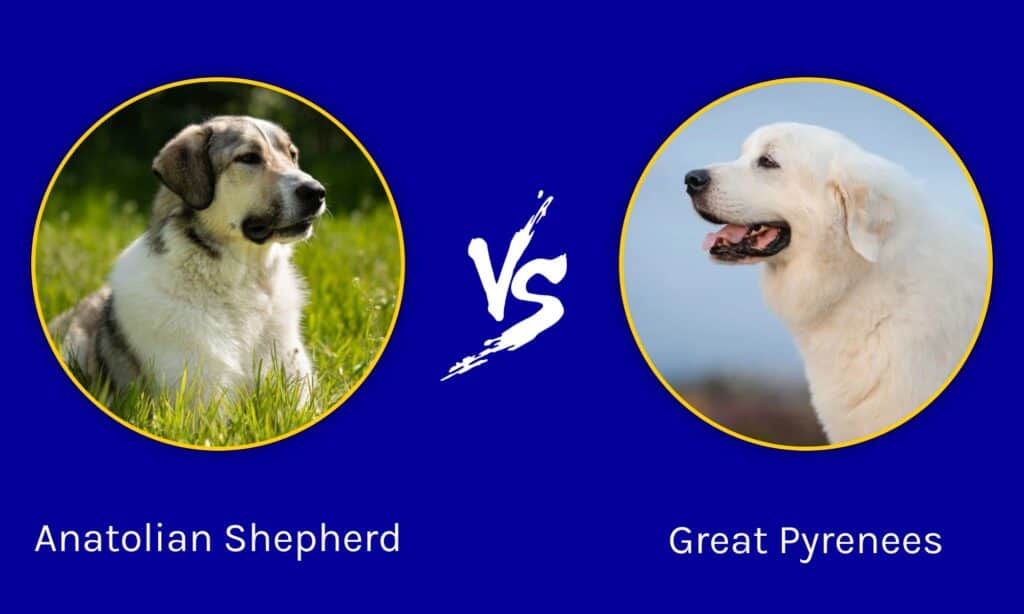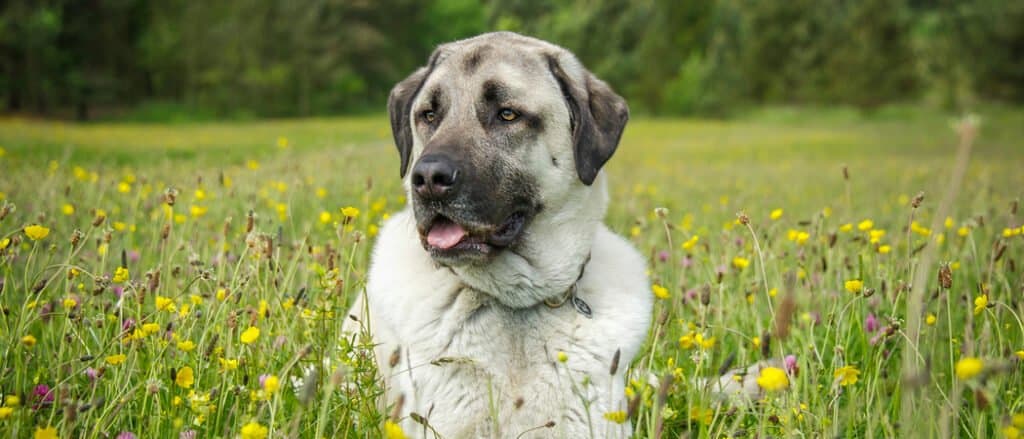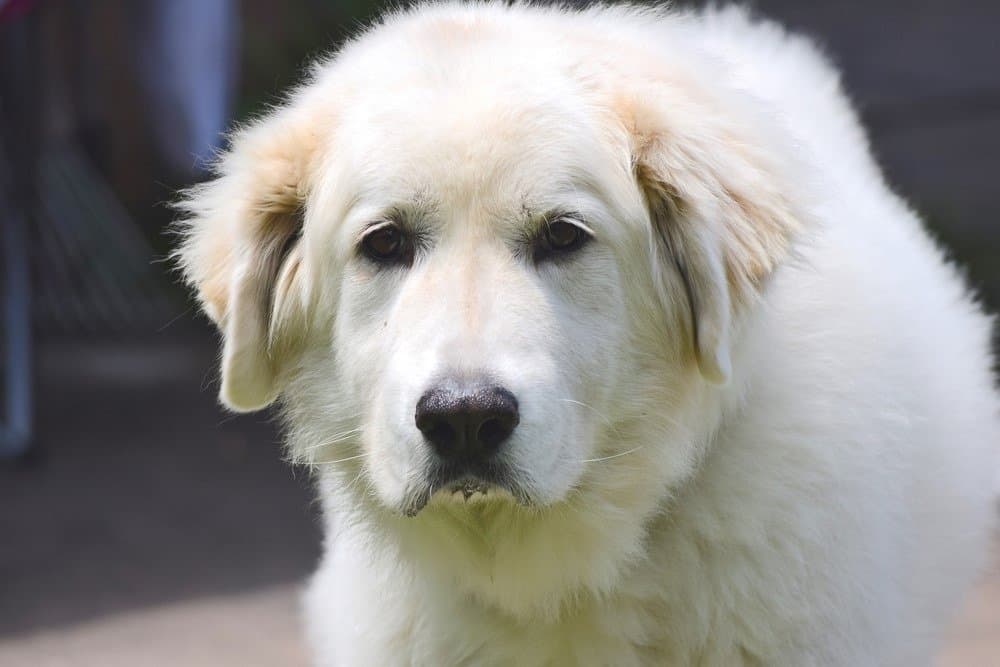The Anatolian Shepherd and Great Pyrenees are quite different from one another despite both showing strong guarding tendencies.
The Anatolian Shepherd is characterized by long legs and neck, a curled-up tail, a deep chest, drooping triangle-shaped ears, and a big skull. Great Pyrenees are very large white dogs. Since they were bred to watch over flocks of sheep, they can be quite protective of their family members.
Let’s take a closer look at these breeds and their differences!
Comparing Anatolian Shepherd vs Great Pyrenees

| Characteristic | Anatolian Shepherd | Great Pyrenees |
|---|---|---|
| Size | 27-29 inches, 80-150 pounds | 25-32 inches, 85+ pounds |
| Appearance | Smooth, short coat in the colors blue fawn, brindle, fawn, liver, red fawn, white, biscuit and white, and grey fawn | Long double coat in white with tan, grey, badger, or reddish-brown markings |
| Lifespan | 11-13 years | 10-12 years |
| Temperament | Independent, reserved | Affectionate, takes time to warm to strangers |
| Trainability | Difficult | Intermediate |
| Drooling Level | Low | Moderate |
Key Differences Between Anatolian Shepherd and Great Pyrenees
The key difference between the Anatolian Shepherd and Great Pyrenees is their appearance, including coat length, color, and size.
Other differences include lifespan, temperament, trainability, and drooling level.
Let’s take a closer look at these breeds below!
Anatolian Shepherd vs Great Pyrenees: Size

Anatolian Shepherds measure 27-19 inches in height.
©rebeccaashworth/Shutterstock.com
Female Anatolian Shepherds are 27 inches tall, while males measure 29 inches. They can weigh between 80-150 pounds.
Female Great Pyrenees dogs stand 25-29 inches and weigh upwards of 85 pounds. Males are 27-32 inches tall and weigh more than 100 pounds. There is no weight limit for Great Pyrenees dogs, according to the American Kennel Club (AKC).
Because Anatolian Shepherds sit at the middle of a Great Pyrenees standard height, they might be taller, shorter, or the same size. There is less range for Anatolian Shepherd height.
The breeds weigh similarly to one another.
Anatolian Shepherd vs Great Pyrenees: Appearance
Right off the bat, you’ll notice that Anatolian Shepherds have short fur while Great Pyrenees dogs have medium-length coats. You’ll also likely notice the dogs are of different colors.
Great Pyrenees dogs are always white, but they can have tan, grey, badger, or reddish-brown markings.
Anatolian Shepherds come in several colors, including:
- Blue fawn
- Brindle
- Fawn
- Liver
- Red fawn
- White
- Biscuit and white
- Grey fawn
They can also have the following markings:
- Brown mask
- Black mask
- Pinto, black mask
- Pinto
- Dutch markings
- Silver mask
Anatolian Shepherd vs Great Pyrenees: Lifespan

Great Pyrenees dogs typically live shorter lives of 10-12 years.
©Ggeek/Shutterstock.com
Anatolian Shepherds live one year longer than Great Pyrenees dogs on average. While Anatolian Shepherds live 11-13 years, Great Pyrenees dogs live 10-12 years.
Anatolian Shepherd vs Great Pyrenees: Temperament
Both breeds have strong guarding instincts, but the Great Pyrenees tends to be more friendly and affectionate. Great Pyrs take time to get used to new people, but they love their family and might even think of themselves as giant lap dogs!
They can be clingy and are prone to separation anxiety, so it’s a good idea to get them used to spending short periods alone. However, they should never be left alone for long periods and are best suited to families where someone is home most of the day.
Anatolian Shepherds were bred to think independently. They aren’t super lovey-dovey dogs and tend to be incredibly wary of new people and animals.
Anatolian Shepherd vs Great Pyrenees: Trainability

Anatolian Shepherds are independent and difficult to train.
©Liza de Bie/Shutterstock.com
Anatolian Shepherds aren’t recommended for first-time dog owners. They are difficult to train due to their independent thinking. These dogs were originally bred to protect livestock, making their own decisions without human input.
They should never be taken off-leash in an unenclosed space, and the AKC recommends against protection and guard-dog training.
These dogs are calm, steady, and will protect what they see as theirs unconditionally. But with these attributes come downsides. They are also difficult to train and can show aggression toward strange people and animals.
Great Pyrenees dogs were also bred to make independent decisions on the farm, but they truly thrive when they have human company for the majority of the day. However, they aren’t the best listeners. You might notice your Pyrenees becoming bored quickly during training and responding very slowly to commands.
As with any dog, these breeds thrive with short, positive training sessions. Never try to dominate your dog or punish them physically—these methods don’t work and will worsen your relationship with your dog.
These methods also lead to fear and aggression, which, with giant breeds like these, can lead to severe injury.
Anatolian Shepherd vs Great Pyrenees: Drooling
Anatolian Shepherds aren’t heavy droolers. You might notice them dripping water around the water bowl or drooling when you have a tasty treat, but that’s all.
Great Pyrenees drool a lot more! You might have to clean their face from time to time, and they’re likely to leave drool puddles on objects, the floor, and even people.
Are These Two Breeds Good with Children?
Great Pyreneess love children; they are usually gentle, protective, and patient with kids. These dogs need lots of exercise to use up their high energy, and they love to play, so being around children gives them the exercise and play time they want. At the same time, their loyalty to the family makes them perfect guardians for children.
Anatolian Shepherd Dogs might require a little more time to get used to kids, but fortunately, they are easy to train and therefore can be taught how to interact with children. It might be best to wait until the children are older to get an Anatolian Shepherd, however. Keep in mind that the Anatolian Shepherd has a very strong bite (743 PSI), so you would want to make sure that both children and dog understand proper behavior.
The photo featured at the top of this post is © rebeccaashworth/Shutterstock.com
Ready to discover the top 10 cutest dog breeds in the entire world?
How about the fastest dogs, the largest dogs and those that are -- quite frankly -- just the kindest dogs on the planet? Each day, AZ Animals sends out lists just like this to our thousands of email subscribers. And the best part? It's FREE. Join today by entering your email below.
Thank you for reading! Have some feedback for us? Contact the AZ Animals editorial team.






